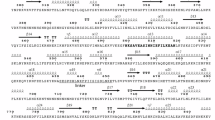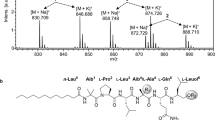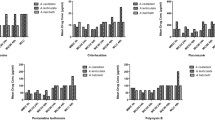Abstract
A 384-well microtitre plate fluorescence cleavage assay was developed to identify inhibitors of the cysteine protease falcipain-2, an important antimalarial drug target. Bioassay-guided isolation of a MeOH extract from a myxobacterium Chitinophaga sp. Y23 isolated from soil collected in Singapore, led to the identification of a new acyltetrapeptide, falcitidin (1), which displayed an IC50 value of 6 μM against falcipain-2. The planar structure of 1 was secured by NMR and MS/MS analysis. Attempts to isolate further material for biological testing were hampered by inconsistent production and by a low yield (<100 μg l−1). The absolute configuration of 1 was determined by Marfey’s analysis and the structure was confirmed through total synthesis as isovaleric acid-D-His-L-Ile-L-Val-L-Pro-NH2. Falcitidin (1) is the first member of a new class of falcipain-2 inhibitors and, unlike other peptide-based inhibitors, does not contain reactive groups that irreversibly bind to active cysteine sites.
Similar content being viewed by others
Log in or create a free account to read this content
Gain free access to this article, as well as selected content from this journal and more on nature.com
or
Accession codes
References
WHO World Malaria Report 2011 〈http://www.who.int/malaria/world_malaria_report_2011〉 (accessed 13 December 2012).
Plowe, C. et al. World Antimalarial Resistance Network (WARN) III: Molecular markers for drug resistant malaria. Malar. J. 6, 121 (2007).
Thomsen, T. T. et al. Prevalence of single nucleotide polymorphisms in the Plasmodium falciparum multidrug resistance gene (Pfmdr-1) in Korogwe District in Tanzania before and after introduction of artemisinin-based combination therapy. Am. J. Trop. Med. Hyg. 85, 979–983 (2011).
Petersen, I., Eastman, R. & Lanzer, M. Drug-resistant malaria: Molecular mechanisms and implications for public health. FEBS Lett. 585, 1551–1562 (2011).
Burrows, J. N., Leroy, D., Lotharius, J. & Waterson, D. Challenges in antimalarial drug discovery. Future Med. Chem. 3, 1401–1412 (2011).
Ettari, R., Bova, F., Zappalà, M., Grasso, S. & Micale, N. Falcipain-2 inhibitors. Med. Res. Rev. 30, 136–167 (2010).
Pandey, K. Cysteine proteases of human malaria parasites. J. Parasit. Dis. 35, 94–103 (2011).
Rosenthal, P. J. in Advances in Experimental Medicine and Biology Vol. 712 (eds Robinson, M. W. & Dalton, J. P.) 30–48 (Springer, New York, 2011).
Sim, T.-S., Loke, P., Lee, M., Singh, M. & Flotow, H. Cloning and sequence characterisation of falcipain-2 from Plasmodium falciparum Gombak A strain (Malaysia). Parasitol. Res. 87, 683–686 (2001).
Kämpfer, P. et al. Transfer of [Flexibacter] sancti, [Flexibacter] filiformis, [Flexibacter] japonensis and [Cytophaga] arvensicola to the genus Chitinophaga and description of Chitinophaga skermanii sp. nov. Int. J. Syst. Evol. Microbiol. 56, 2223–2228 (2006).
Sangkhobol, V. & Skerman, V. B. D. Chitinophaga, a new genus of chitinolytic myxobacteria. Int. J. Syst. Bacteriol. 31, 285–293 (1981).
An, D. S., Im, W. T., Lee, S. T., Choi, W. Y. & Yoon, M. H. Chitinophaga soli sp. nov. and Chitinophaga terrae sp. nov., isolated from soil of a ginseng field in Pocheon Province, Korea. J. Microbiol. Biotechnol. 17, 705–711 (2007).
Cremet, L. et al. Chitinophaga terrae bacteremia in human. Emerg. Infect. Dis. 15, 1134–1135 (2009).
Dehn, R. et al. Molecular basis of elansolid biosynthesis: Evidence for an unprecedented quinone methide initiated intramolecular Diels–Alder cycloaddition/macrolactonization. Angew. Chem. Int. Ed. 50, 3882–3887 (2011).
Jansen, R. et al. Elansolid A3, a unique p-quinone methide antibiotic from Chitinophaga sancti. Chemistry 17, 7739–7744 (2011).
Steinmetz, H. et al. Elansolid A, a unique macrolide antibiotic from Chitinophaga sancti isolated as two stable atropisomers. Angew. Chem. Int. Ed. 50, 532–536 (2011).
Nawrath, T., Gerth, K., Müller, R. & Schulz, S. Volatile methyl esters of medium chain length from the bacterium Chitinophaga Fx7914. Chem. Biodiversity 7, 2228–2253 (2010).
Johnson, R. S., Martin, S. A., Biemann, K., Stults, J. T. & Watson, J. T. Novel fragmentation process of peptides by collision-induced decomposition in a tandem mass spectrometer: differentiation of leucine and isoleucine. Anal. Chem. 59, 2621–2625 (1987).
Marfey, P. Determination of D-amino acids. II. Use of a bifunctional reagent, 1,5-difluoro-2,4-dinitrobenzene. Carlsberg Res. Commun. 49, 591–596 (1984).
Bhushan, R. & Brückner, H. Use of Marfey's reagent and analogs for chiral amino acid analysis: Assessment and applications to natural products and biological systems. J. Chromatogr. B 879, 3148–3161 (2011).
Chiou, S.-H. & Wang, K.-T. Peptide and protein hydrolysis by microwave irradiation. J. Chromatogr. B 491, 424–431 (1989).
Lill, J. R., Ingle, E. S., Liu, P. S., Pham, V. & Sandoval, W. N. Microwave-assisted proteomics. Mass Spectrom. Rev. 26, 657–671 (2007).
Carpino, L. A., Ionescu, D. & El-Faham, A. Peptide coupling in the presence of highly hindered tertiary amines. J. Org. Chem. 61, 2460–2465 (1996).
Bambino, F., Brownlee, R. T. C. & Chiu, F. C. K. Facile synthesis of protected dipeptide acids containing C-terminal α,α-dialkyl amino acids. Tetrahedron Lett. 32, 3407–3408 (1991).
Seok Choi, J., Kang, H., Jeong, N. & Han, H. Orthogonality and compatibility between Tsc and Fmoc amino-protecting groups. Tetrahedron 61, 2493–2503 (2005).
Niestroj, A. J. et al. Inhibition of mammalian legumain by Michael acceptors and AzaAsn-halomethylketones. Biol. Chem. 383, 1205–1214 (2005).
Flotow, H., Leong, C.-Y & Buss, A. D. Development of a plasmepsin II fluorescence polarization assay suitable for high throughput antimalarial drug discovery. J. Biomol. Screen. 7, 367–371 (2002).
Ovenden, S. P. B et al. Spermine alkaloids from Albizia adinocephala with activity against Plasmodium falciparum plasmepsin II. Phytochemistry 60, 175–177 (2002).
Yang, L. K. et al. Pyrrole carboxamidine tryptase inhibitors from Leptonychia pubescens. Planta Med. 71, 1071–1072 (2005).
Acknowledgements
We thank the National University of Singapore for a Graduate Scholarship (to SRK) and generous funding from the National Medical Research Council (NMRC/IRG11may097) of Singapore (to MJL).
Author information
Authors and Affiliations
Corresponding author
Additional information
Supplementary Information accompanies the paper on The Journal of Antibiotics website
Supplementary information
Rights and permissions
About this article
Cite this article
Somanadhan, B., Kotturi, S., Yan Leong, C. et al. Isolation and synthesis of falcitidin, a novel myxobacterial-derived acyltetrapeptide with activity against the malaria target falcipain-2. J Antibiot 66, 259–264 (2013). https://doi.org/10.1038/ja.2012.123
Received:
Revised:
Accepted:
Published:
Issue date:
DOI: https://doi.org/10.1038/ja.2012.123
Keywords
This article is cited by
-
Alternatives to currently used antimalarial drugs: in search of a magic bullet
Infectious Diseases of Poverty (2016)



